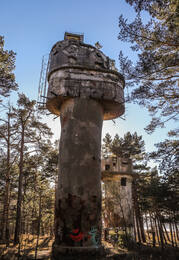Minos, bombos, torpedos ir cheminis ginklas Baltijos jūroje
Pirmosiomis 2010 m. vasario dienomis Švedijos televizijos kanale SVT pasirodė naujienos, kurios sukrėtė ir labai nustebino daugelį.
Būtent buvo teigta, kad 10-ojo dešimtmečio pradžioje Rusijos kariuomenė, išvedusi savo karius iš Baltijos šalių, iš Liepojos uosto išvežė konteinerius su cheminiu ginklu ir branduolinėmis atliekomis ir nuskandino juos Baltijos jūroje prie Gotlando salos. Maža to, apie tai esą buvo informuota Švedijos vyriausybė, tačiau šis faktas buvo laikomas paslaptyje... Rusijos pusė šį faktą neigia, o Latvijos gynybos ministerija leidžia galimybę, kad karinio turinio išvedimo metu galėjo būti nuskandinti kai kurie konteineriai su kariniu turiniu, nors konkrečių faktų apie tai nėra... Ar kas nors bandys šią informaciją patikrinti ir kas su visa tai bus, parodys laikas. Tačiau karts nuo karto visame Baltijos jūros regione žiniasklaidoje iškyla Baltijos jūroje nuskendusių ginklų ir praėjusių dviejų pasaulinių karų padarinių ir jų palikimo klausimas.
Didelio masto išminavimo operacijos Baltijos jūroje vyksta beveik kasmet, nes tiek I, tiek II pasaulinių karų metu jūra buvo smarkiai užminuota. Rastos ir utilizuojamos Rusijoje pagamintos inkarinės minos M-08, M-12, KB, Vokietijoje pagamintos magnetinės dugninės minos LMB, vokiečių ir rusų gamybos torpedos ir kiti panašūs lobiai. Netgi 1908 ir 1912 metais pagamintos jūrinės minos vis dar yra pavojingos, žvejai vis dar susiduria su jomis ir dažnai aptinkamos prie laivybos kelių, net Irbės sąsiauryje. Ekspertų skaičiavimais, jūroje vis dar gali būti apie 28 000 minų ir sprogstamųjų objektų, iš kurių apie 15 000 yra Irbės sąsiauryje, netoli laivybos kelių.
Tačiau pavojingų radinių gali pasitaikyti ne tik toli nuo kranto, bet ir uosto akvatorijoje. Pavyzdžiui, Liepojos uosto akvatorijoje rastas ne vienas minosvaidžio sviedinys ir sprogstamasis objektas, kaip kadaise čia vykusių kautynių įrodymas. Bet tai dar ne viskas. Po Antrojo pasaulinio karo į Baltijos jūrą buvo išmestas didžiulis kiekis cheminio ginklo – apie 40 000 tonų. Juose buvo garstyčių dujų, nervinių dujų tabuno, dusinančių dujų fosgeno ir arseno turinčių junginių. Po karo ši cheminė amunicija dideliais kiekiais buvo išmesta netoli Danijai priklausančios Bornholmo salos, netoli Švedijai priklausančios Gotlando salos ir apie 100 kilometrų į vakarus nuo Liepojos. Greičiausiai jie buvo paimti tiesiai iš Liepojos uosto, o dalis šovinių nuskandinta jų neišvežant į šias skęstimo vietas ir gana nedideliame gylyje (tik 20 metrų!). Kyla įtarimų, kad amunicija, kuri tada buvo užkasta medinėse dėžėse, laikui bėgant buvo veikiama srovių ir dabar galimai išsibarsčiusi neįsivaizduojamai dideliuose plotuose.
Yra gana prieštaringų nuomonių apie šios amunicijos keliamą pavojų. Viena vertus, keliamas pavojaus signalas, žiniasklaida rašo apie šprotus garstyčiose, bet kita vertus, prieš trisdešimt metų Danijos sąsiauryje paleistas užtaisas buvo surūdijęs ir tušti, netoliese nebuvo aptikta jokios taršos, manoma, kad kenksmingos dujos fosgenas ir tabunas laikui bėgant suyra. Kitas dalykas – garstyčių dujos, kurios esant artimai nuliui temperatūrai užšąla apatiniuose vandens sluoksniuose, toje agregacijos būsenoje yra nekenksmingos ir nepajėgios plūduriuoti. Tačiau jau 10-ojo dešimtmečio pradžioje Liepojos apylinkių žvejai ne kartą ištraukė tokias kovines galvutes su garstyčiomis savo tinkluose, o tai sukėlė didelių sveikatos problemų, nes garstyčios įšilo ir greitai atgavo toksines savybes saulės šviesoje ir šiltoje oro temperatūroje. Pirmieji panašūs atvejai užfiksuoti praėjusio amžiaus šeštajame dešimtmetyje, o laikui bėgant žvejai išmoko vengti pavojingų zonų. Tačiau galime tik spėlioti, kiek iš tikrųjų cheminės galvutės yra nuo Liepojos uosto.
Nepamirškime, kad Kuršų katile pačiu paskutinę karo akimirką vyko smarkūs mūšiai, buvo sutelktos reikšmingos kontrpajėgos ir ginkluotė. Netikėtai Klaipėdos paplūdimyje rastas cheminės kovos agento užtaisas, papuoštas vokišku užrašu „Yperit“, gali tapti rimtu įspėjimu. Taigi kaukole papuoštame sviedinyje buvo garstyčių dujų. Žmonės iš paplūdimio buvo greitai evakuoti, tačiau sviedinys žalos nepadarė. Pranešama, kad po šio incidento Lietuva sukėlė tarptautinį šurmulį dėl į jūrą išmestų ginklų, tačiau skandalas pamažu nurimo ir tyliai nutilo. Viena vertus, manoma, kad Baltijos jūra dėl šių cheminių užtaisų gali tapti negyva jūra ir visa joje esanti gyvybė gali žūti, kad nuodingos medžiagos gali sukelti gyvybės formų mutacijas ir laikui bėgant nukentės ir žmonės. Švedijoje kai kurie mokslininkai išreiškė nuomonę, kad pastaraisiais dešimtmečiais vėžiu sergančių pacientų skaičius pastebimai išaugo Baltijos jūros šalyse, ir mano, kad taip yra dėl į jūrą išmestų cheminių karinių medžiagų, kurios pamažu prasiskverbia į supančią aplinką ir patenka į orą. Vieni mano, kad Baltijos jūrą laukia dar vieno Černobylio likimas, kiti mano, kad pavojus gerokai pervertintas ir todėl apsimeta šios problemos nematantys.
Apollo.lv; Delfi.lv; Tvnet.lv; Metai; Kurzemes-vards.lv; Liepajniekiem.lv
Susijusios vietos
Karosta, Liepojos karinis uostas (ekskursija)
Karosta yra didžiausia istorinė karinė teritorija Baltijos šalyse ir užima beveik trečdalį visos Liepojos teritorijos. Karosta – unikalus karinių ir įtvirtinimų pastatų kompleksas Baltijos jūros pakrantėje, turintis ypatingą reikšmę Latvijos ir pasaulio istorijoje bei architektūroje. Karostoje yra tokie karinio paveldo objektai kaip Šiaurinis molas ir fortai, Redanas, Karostos kalėjimas, Karostos vandens bokštas, Šv. Nikolajaus stačiatikių Jūros katedra, Oskaro Kalpako tiltas ir kiti.






